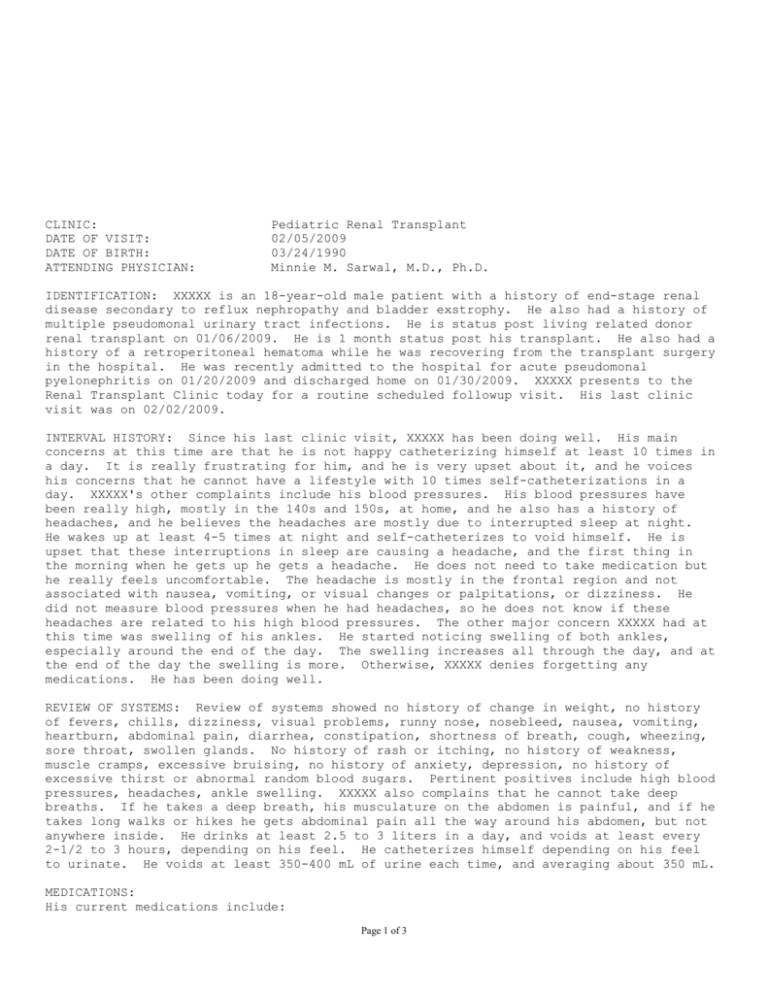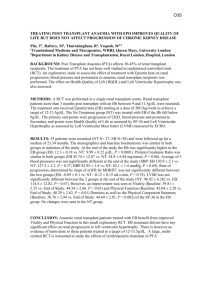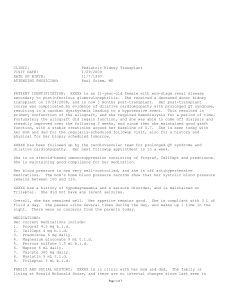LPCH 10 - Clinic Visit
advertisement

CLINIC: DATE OF VISIT: DATE OF BIRTH: ATTENDING PHYSICIAN: Pediatric Renal Transplant 02/05/2009 03/24/1990 Minnie M. Sarwal, M.D., Ph.D. IDENTIFICATION: XXXXX is an 18-year-old male patient with a history of end-stage renal disease secondary to reflux nephropathy and bladder exstrophy. He also had a history of multiple pseudomonal urinary tract infections. He is status post living related donor renal transplant on 01/06/2009. He is 1 month status post his transplant. He also had a history of a retroperitoneal hematoma while he was recovering from the transplant surgery in the hospital. He was recently admitted to the hospital for acute pseudomonal pyelonephritis on 01/20/2009 and discharged home on 01/30/2009. XXXXX presents to the Renal Transplant Clinic today for a routine scheduled followup visit. His last clinic visit was on 02/02/2009. INTERVAL HISTORY: Since his last clinic visit, XXXXX has been doing well. His main concerns at this time are that he is not happy catheterizing himself at least 10 times in a day. It is really frustrating for him, and he is very upset about it, and he voices his concerns that he cannot have a lifestyle with 10 times self-catheterizations in a day. XXXXX's other complaints include his blood pressures. His blood pressures have been really high, mostly in the 140s and 150s, at home, and he also has a history of headaches, and he believes the headaches are mostly due to interrupted sleep at night. He wakes up at least 4-5 times at night and self-catheterizes to void himself. He is upset that these interruptions in sleep are causing a headache, and the first thing in the morning when he gets up he gets a headache. He does not need to take medication but he really feels uncomfortable. The headache is mostly in the frontal region and not associated with nausea, vomiting, or visual changes or palpitations, or dizziness. He did not measure blood pressures when he had headaches, so he does not know if these headaches are related to his high blood pressures. The other major concern XXXXX had at this time was swelling of his ankles. He started noticing swelling of both ankles, especially around the end of the day. The swelling increases all through the day, and at the end of the day the swelling is more. Otherwise, XXXXX denies forgetting any medications. He has been doing well. REVIEW OF SYSTEMS: Review of systems showed no history of change in weight, no history of fevers, chills, dizziness, visual problems, runny nose, nosebleed, nausea, vomiting, heartburn, abdominal pain, diarrhea, constipation, shortness of breath, cough, wheezing, sore throat, swollen glands. No history of rash or itching, no history of weakness, muscle cramps, excessive bruising, no history of anxiety, depression, no history of excessive thirst or abnormal random blood sugars. Pertinent positives include high blood pressures, headaches, ankle swelling. XXXXX also complains that he cannot take deep breaths. If he takes a deep breath, his musculature on the abdomen is painful, and if he takes long walks or hikes he gets abdominal pain all the way around his abdomen, but not anywhere inside. He drinks at least 2.5 to 3 liters in a day, and voids at least every 2-1/2 to 3 hours, depending on his feel. He catheterizes himself depending on his feel to urinate. He voids at least 350-400 mL of urine each time, and averaging about 350 mL. MEDICATIONS: His current medications include: Page 1 of 3 1. 2. 3. 4. 5. 6. 7. 8. 9. 10. 11. 12. Prograf 8.5 mg p.o. in the morning and 8 mg in the evening. CellCept 750 mg twice a day; that comes to 426 mg/sq m per dose. Magnesium 2 tablets twice a day. Pepcid 20 mg twice a day. Valcyte 450 mg once a day. Ciprofloxacin 1 tablet at night. Detrol 6 mg at 6 p.m. once a day. Amlodipine 10 mg twice a day. Reglan 5 mg three times a day. Sodium bicarbonate 3 tablets three times a day. Colace 1 tablet twice a day. MiraLax p.r.n. PHYSICAL EXAMINATION: VITAL SIGNS: Weight 64.8 kg; it has come down from 66 kg on February 02, 2009. Height 172.1 cm. Blood pressure 143/76. GENERAL: Active, alert, not in acute distress. He has apparently been very emotional about self-catheterizing himself and has been crying. HEENT: Within normal limits. CHEST: Clear breath sounds bilaterally. HEART: S1 and S2 heard. No murmurs. ABDOMEN: Soft. It has been a little tender on his left side and also on the place where he had his renal transplant in the right lower quadrant, and he would not let us touch his abdomen much. He has mild tenderness in the suprapubic region. No CVA tenderness noted at this time. Of course, he had his bilateral nephrectomies done. GENITALIA: Deferred at this time. EXTREMITIES: Full range of motion. Ankle edema noted bilaterally. Pitting edema noted bilaterally. SKIN: No lesions. NEUROLOGIC: Neurologically intact. LABORATORY STUDIES: His most recent labs are from today: Total WBC 5.1, hemoglobin 8.2, hematocrit 24.2, platelets 289,000. Sodium 145, potassium 5.7, chloride 110, bicarbonate 23, BUN 24, creatinine 2.17, glucose 88, anion gap 12, calcium 9.8, phosphorus 3.3, magnesium 2. Prograf 6.4. Urinalysis: Clean catch showed a specific gravity of 1.009, glucose negative, ketones negative, blood trace, pH 7.5, protein negative, nitrites negative, leukocyte esterase negative, RBC 4-5, WBC 0-2, bacteruria negative. CMV DNA PCR done on 02/03/2009 is negative. Last urine culture on 02/02/2009 showed no growth. Recent renal ultrasound was done on 02/02/2009 and showed stable moderate pelviectasis, normal renal ultrasound. The urinary bladder is normal in shape, contour and wall thickness. There is a small amount of echogenic layering sediment in the posterior bladder wall. The transplant kidney in the right lower quadrant demonstrates normal cortical echogenicity and corticomedullary differentiation. There is stable, moderate pelviectasis, and the transverse dimension of the renal pelvis is 1.68 cm. There is mild dilatation of the proximal ureter, measuring 7 mm. Normal blood flow on waveforms are seen in the main and intralobular artery and main renal vein of the transplant kidney. Resistive indices in the intralobular arteries ranged from 0.58 to 0.72. The velocity in the renal artery ranged from 0.57 to 0.63 per second. The renal artery resistive indices are within normal limits. Page 2 of 3 ASSESSMENT AND PLAN: XXXXX is an 18-year-old male patient with a history of end-stage renal disease secondary to reflux nephropathy, status post bilateral native nephrectomies, status post living related donor renal transplant on 01/06/2009, from his dad, status post retroperitoneal hematoma evacuation on 01/10/2009. Apparently his main issues have been self-catheterization for 10 times a day, which is frustrating XXXXX totally, and he is not happy with his lifestyle. We have tried talking to Dr. Kennedy and his nurse, Cathy, in regard to his voiding habits year-old see if we can help him reduce the number of self-catheterizations in a day, but apparently we could not talk to Dr. Kennedy as he was in the OR. We will followup with Dr. Kennedy. 1. RENAL: Regarding his renal function, his creatinine has been persistently at 2.2, and it is coming down slowly, 2.14 to 2.17. We anticipate some more decrease in his serum creatinine as he goes further away on his transplant. His potassium is a little bit high, but we did not make any changes at this time. Otherwise, no other electrolyte abnormalities at this time. He needs to be on magnesium, as well as sodium bicarbonate, to prevent acidosis and also hypomagnesemia. He is on Prograf and CellCept for his immunosuppression. Target levels for Prograf are between 10-12, and his level is 6.4 today. The plan is to give an extra 1 mg p.o. now and then increase the Prograf dose to 8.5 mg twice a day. 2. UROLOGY: In terms of his urology, XXXXX will make an appointment with Urology, and then we will come up with a plan regarding his self-catheterization. 3. CARDIOVASCULAR: He is pretty hypertensive at this time. Our goal blood pressures for XXXXX are around the 120s, but definitely note above 130, so we plan to start him on atenolol 25 mg twice a day, along with amlodipine 10 mg twice a day. XXXXX does not like a Catapres patch on him, so we started him on atenolol. 4. INFECTIOUS DISEASE: He cannot take Septra, as his creatinine has been persistently high, so we plan inhaled pentamidine for him. He is going to get next inhaled pentamidine on 02/10/2009 at 6:30 p.m. in the day hospital. He continues to be on Valcyte 450 mg once a day, and he continues to be on ciprofloxacin for his urinary tract infection prophylaxis. 5. GASTROINTESTINAL: XXXXX's constipation has improved, so he continues to be on the current regimen of Colace 1 tablet twice a day and MiraLax p.r.n. as needed, and continues to be on Reglan 5 mg three times a day. Our plan is to follow him up in a week from now, and we will repeat a Prograf level the day after tomorrow. The case was discussed in detail with Dr. Sarwal. Page 3 of 3






